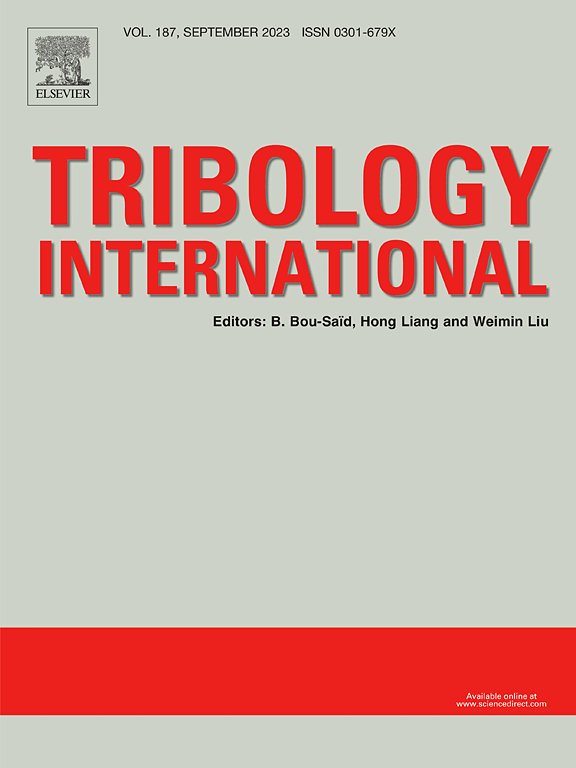一种用于热加工模具的新型Ni-Mo-W-V马氏体钢:通过热稳定的MC纳米沉淀物改善高温机械性能和耐磨性
IF 6.1
1区 工程技术
Q1 ENGINEERING, MECHANICAL
引用次数: 0
摘要
随着工业技术的不断进步,人们对能够承受更高工作温度和更苛刻加载条件的热加工模具的需求越来越大。因此,热加工模具钢必须表现出特殊的高温强度,以提高耐磨性。在本研究中,通过添加Mo、W和V来促进MC纳米碳化物的析出,制备了马氏体低合金23CrNi3Mo2WV (PG)钢。实验结果表明,PG在700℃时的极限抗拉强度达到543 ± 15 MPa,比5CrNiMo钢的极限抗拉强度高322 ± 20 MPa。经过500℃的磨损试验,PG的磨损率为4.39 ± 0.24 × 10-7 mm³/N/m,明显低于5CrNiMo。显微组织分析进一步揭示了回火后PG钢中析出针状MC纳米碳化物,相对于5CrNiMo钢中的M3C碳化物表现出更高的热稳定性。MC碳化物与马氏体基体呈(100)MC//(100)α′的Baker-Nutting (B-N)取向关系(OR),在500℃下进行磨损试验后仍保持这种B-N取向关系。与5CrNiMo钢相比,PG钢中这种稳定的取向关系有助于提高强度和降低磨损率。因此,PG钢是热加工模具应用的有前途的材料,在高温下提供延长的使用寿命。本文章由计算机程序翻译,如有差异,请以英文原文为准。
A novel Ni–Mo–W–V martensitic steel for hot working dies: Improved elevated–temperature mechanical properties and wear resistance via thermally stable MC nanoprecipitates
With the continuous advancement of industrial technologies, there is an increasing demand for hot working dies that can withstand higher operational temperatures and more severe loading conditions. Consequently, hot working die steels must exhibit exceptional elevated temperature strength to improve wear resistance. In this study, a martensitic low–alloy 23CrNi3Mo2WV (PG) steel is developed by incorporating Mo, W, and V to promote the precipitation of MC nanoscale carbides. Experimental results demonstrate that the ultimate tensile strength of PG reaches 543 ± 15 MPa at 700 °C, which is 322 ± 20 MPa higher than that of 5CrNiMo steel. Furthermore, the wear rate of PG is 4.39 ± 0.24 × 10–7 mm³/N/m after a wear test at 500 °C, significantly lower than that of 5CrNiMo. Microstructural analysis further reveals the precipitation of needle–like MC nanocarbides in the PG steel after tempering, which exhibits higher thermal stability relative to M3C carbides in the 5CrNiMo steel. The MC carbides follow a Baker–Nutting (B–N) orientation relationship (OR) of with the martensitic matrix, and this B–N OR is remained following the wear test at 500 °C. This stable orientation relationship in PG steel contributes to the higher strength and lower wear rate compared to 5CrNiMo steel. Therefore, PG steel is a promising material for hot working die applications, offering an extended service life at elevated temperatures.
求助全文
通过发布文献求助,成功后即可免费获取论文全文。
去求助
来源期刊

Tribology International
工程技术-工程:机械
CiteScore
10.10
自引率
16.10%
发文量
627
审稿时长
35 days
期刊介绍:
Tribology is the science of rubbing surfaces and contributes to every facet of our everyday life, from live cell friction to engine lubrication and seismology. As such tribology is truly multidisciplinary and this extraordinary breadth of scientific interest is reflected in the scope of Tribology International.
Tribology International seeks to publish original research papers of the highest scientific quality to provide an archival resource for scientists from all backgrounds. Written contributions are invited reporting experimental and modelling studies both in established areas of tribology and emerging fields. Scientific topics include the physics or chemistry of tribo-surfaces, bio-tribology, surface engineering and materials, contact mechanics, nano-tribology, lubricants and hydrodynamic lubrication.
 求助内容:
求助内容: 应助结果提醒方式:
应助结果提醒方式:


